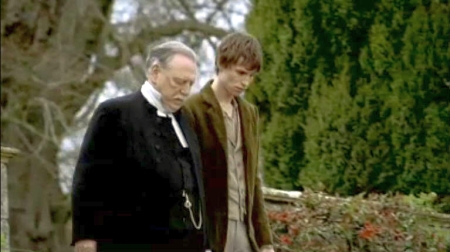I am anxiously awaiting the start of Part 1 of Masterpiece Theatre's
Bleak House, which premieres tonight at 9:00 PM EST on PBS. I'm not a huge fan, having read
A Tale of Two Cities in high school and summarily dismissed Dickens as having used too many words to describe too many characters. Indeed, the
"Who's Who" page for the series has no fewer than 42 profiles.
Bleak House, however, has the advantage of featuring
spontaneous human combustion, and this version has the added draw of
Gillian Anderson in the role of Lady Dedlock (
"Scully!").
While I watch the case of
Jarndyce v Jarndyce unfold, I will be happily stuffing sheets of paper into meticulously labelled manila envelopes.
As I
reported back in October, I have been seeking a means to upgrade and simplify filing of items from the bibliography. The bulk of my collection are photocopies and printouts: hundreds and hundreds of critical articles from books and journals, newspaper columns from microfilm, .pdf documents. I also have copies of poems, criticism, and book reviews written by Reed himself. My file boxes are full-to-brimming, and reams of unfiled (and uncatalogued) material have been piling up into treacherous, teetering mounds on my desk. Since my desk is a particularly valuable piece of real estate currently located in the kitchen, this is both unsightly and inefficient.
Excited by the discovery of the Noguchi filing system, I decided to invest in an open shelf filing system. To this end, I have:
- Ordered storage cubes, which can be stacked into a bookcase. Should arrive in two weeks.
- Purchased several boxes of C4 (9x12") manila envelopes, and a stock of new, fine-tipped black markers and pens.
- Begun filing items into envelopes, working my way down from the tops of the most obtrusive piles, like an archeologist.
Already, I'm anticipating problems. I decided that the Noguchi-style of cropping the tops off envelopes was going to be too time-consuming and wasteful, and I looked for clasp-free envelopes without success. The metal clasp on each envelope increases the overall thickness, and I can see them reducing the linear storage capacity of a shelf by inches. The envelope flap also has a gummed edge which could possibly damage the document: I'm folding these inside, behind the paper. I also fear I will have to resort to some sort of color-coding system, despite the unholy hatred I feel for those little sticky, multicolored, placemarking tabs. (It's a library clerk thing.) I'll shut up, now. It's starting.
Ow! She's a Bleak — House
She's mighty, mighty, just lettin' it all hang out
Ow! She's a Bleak — House
I like Dickens stacked, that's a fact, ain't holdin' nothin' back
Ow! She's a Bleak — House
Well-built together, everybody knows, this is how the story goes....









